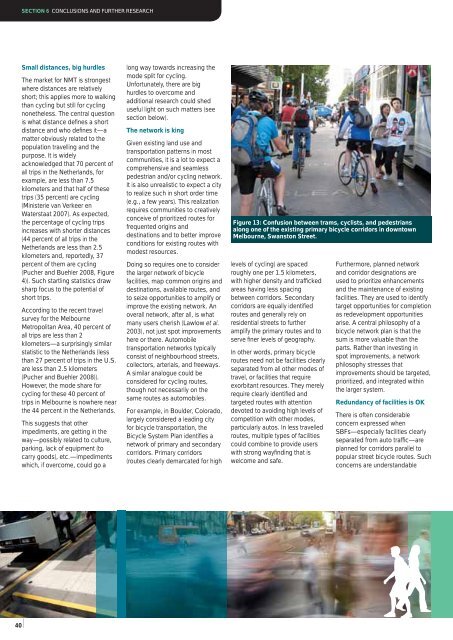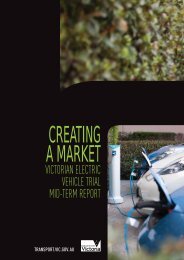Walking and Cycling International Literature Review - Department of ...
Walking and Cycling International Literature Review - Department of ...
Walking and Cycling International Literature Review - Department of ...
You also want an ePaper? Increase the reach of your titles
YUMPU automatically turns print PDFs into web optimized ePapers that Google loves.
SECTION 6 CONCLUSIONS AND FURTHER RESEARCH<br />
Small distances, big hurdles<br />
The market for NMT is strongest<br />
where distances are relatively<br />
short; this applies more to walking<br />
than cycling but still for cycling<br />
nonetheless. The central question<br />
is what distance defi nes a short<br />
distance <strong>and</strong> who defi nes it—a<br />
matter obviously related to the<br />
population travelling <strong>and</strong> the<br />
purpose. It is widely<br />
acknowledged that 70 percent <strong>of</strong><br />
all trips in the Netherl<strong>and</strong>s, for<br />
example, are less than 7.5<br />
kilometers <strong>and</strong> that half <strong>of</strong> these<br />
trips (35 percent) are cycling<br />
(Ministerie van Verkeer en<br />
Waterstaat 2007). As expected,<br />
the percentage <strong>of</strong> cycling trips<br />
increases with shorter distances<br />
(44 percent <strong>of</strong> all trips in the<br />
Netherl<strong>and</strong>s are less than 2.5<br />
kilometers <strong>and</strong>, reportedly, 37<br />
percent <strong>of</strong> them are cycling<br />
(Pucher <strong>and</strong> Buehler 2008, Figure<br />
4)). Such startling statistics draw<br />
sharp focus to the potential <strong>of</strong><br />
short trips.<br />
According to the recent travel<br />
survey for the Melbourne<br />
Metropolitan Area, 40 percent <strong>of</strong><br />
all trips are less than 2<br />
kilometers—a surprisingly similar<br />
statistic to the Netherl<strong>and</strong>s (less<br />
than 27 percent <strong>of</strong> trips in the U.S.<br />
are less than 2.5 kilometers<br />
(Pucher <strong>and</strong> Buehler 2008)).<br />
However, the mode share for<br />
cycling for these 40 percent <strong>of</strong><br />
trips in Melbourne is nowhere near<br />
the 44 percent in the Netherl<strong>and</strong>s.<br />
This suggests that other<br />
impediments, are getting in the<br />
way—possibly related to culture,<br />
parking, lack <strong>of</strong> equipment (to<br />
carry goods), etc.—impediments<br />
which, if overcome, could go a<br />
long way towards increasing the<br />
mode split for cycling.<br />
Unfortunately, there are big<br />
hurdles to overcome <strong>and</strong><br />
additional research could shed<br />
useful light on such matters (see<br />
section below).<br />
The network is king<br />
Given existing l<strong>and</strong> use <strong>and</strong><br />
transportation patterns in most<br />
communities, it is a lot to expect a<br />
comprehensive <strong>and</strong> seamless<br />
pedestrian <strong>and</strong>/or cycling network.<br />
It is also unrealistic to expect a city<br />
to realize such in short order time<br />
(e.g., a few years). This realization<br />
requires communities to creatively<br />
conceive <strong>of</strong> prioritized routes for<br />
frequented origins <strong>and</strong><br />
destinations <strong>and</strong> to better improve<br />
conditions for existing routes with<br />
modest resources.<br />
Doing so requires one to consider<br />
the larger network <strong>of</strong> bicycle<br />
facilities, map common origins <strong>and</strong><br />
destinations, available routes, <strong>and</strong><br />
to seize opportunities to amplify or<br />
improve the existing network. An<br />
overall network, after all, is what<br />
many users cherish (Lawlow et al.<br />
2003), not just spot improvements<br />
here or there. Automobile<br />
transportation networks typically<br />
consist <strong>of</strong> neighbourhood streets,<br />
collectors, arterials, <strong>and</strong> freeways.<br />
A similar analogue could be<br />
considered for cycling routes,<br />
though not necessarily on the<br />
same routes as automobiles.<br />
For example, in Boulder, Colorado,<br />
largely considered a leading city<br />
for bicycle transportation, the<br />
Bicycle System Plan identifi es a<br />
network <strong>of</strong> primary <strong>and</strong> secondary<br />
corridors. Primary corridors<br />
(routes clearly demarcated for high<br />
Figure 13: Confusion between trams, cyclists, <strong>and</strong> pedestrians<br />
along one <strong>of</strong> the existing primary bicycle corridors in downtown<br />
Melbourne, Swanston Street.<br />
levels <strong>of</strong> cycling) are spaced<br />
roughly one per 1.5 kilometers,<br />
with higher density <strong>and</strong> traffi cked<br />
areas having less spacing<br />
between corridors. Secondary<br />
corridors are equally identifi ed<br />
routes <strong>and</strong> generally rely on<br />
residential streets to further<br />
amplify the primary routes <strong>and</strong> to<br />
serve fi ner levels <strong>of</strong> geography.<br />
In other words, primary bicycle<br />
routes need not be facilities clearly<br />
separated from all other modes <strong>of</strong><br />
travel, or facilities that require<br />
exorbitant resources. They merely<br />
require clearly identifi ed <strong>and</strong><br />
targeted routes with attention<br />
devoted to avoiding high levels <strong>of</strong><br />
competition with other modes,<br />
particularly autos. In less travelled<br />
routes, multiple types <strong>of</strong> facilities<br />
could combine to provide users<br />
with strong wayfi nding that is<br />
welcome <strong>and</strong> safe.<br />
Furthermore, planned network<br />
<strong>and</strong> corridor designations are<br />
used to prioritize enhancements<br />
<strong>and</strong> the maintenance <strong>of</strong> existing<br />
facilities. They are used to identify<br />
target opportunities for completion<br />
as redevelopment opportunities<br />
arise. A central philosophy <strong>of</strong> a<br />
bicycle network plan is that the<br />
sum is more valuable than the<br />
parts. Rather than investing in<br />
spot improvements, a network<br />
philosophy stresses that<br />
improvements should be targeted,<br />
prioritized, <strong>and</strong> integrated within<br />
the larger system.<br />
Redundancy <strong>of</strong> facilities is OK<br />
There is <strong>of</strong>ten considerable<br />
concern expressed when<br />
SBFs—especially facilities clearly<br />
separated from auto traffi c—are<br />
planned for corridors parallel to<br />
popular street bicycle routes. Such<br />
concerns are underst<strong>and</strong>able<br />
40

















